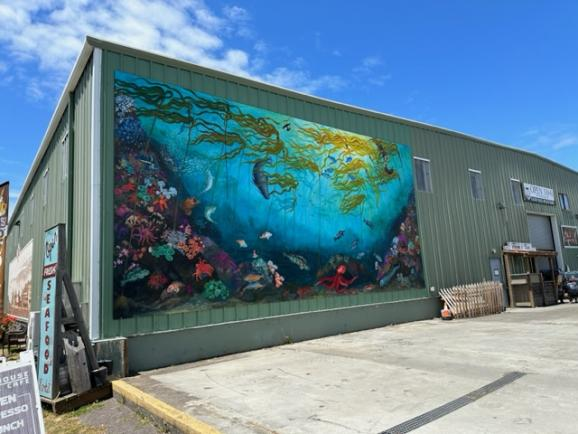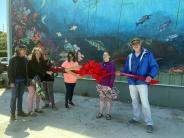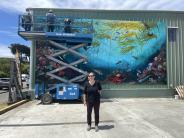Great Kelp Forest Project Mural

Our Forests Below
A healthy bull kelp forest provides important habitat for a variety of marine life such as rockfish, abalone, and sea stars. In Oregon's cold, nutrient-rich waters bull kelp can thrive and grow up to 100 feet tall in a single year. The forest cycles these crucial nutrients, including carbon, throughout our coastal ecosystems. But a recent increase in ocean temperatures, the loss of top predators, and a massive increase in purple sea urchins have combined to seriously threaten this important local habitat and all who rely on it.
The Great Kelp Forest Project is an art/science initiative developed through a partnership between the Port of Bandon and local artist Vicki Affatati. The project received funding support from the Al Pierce Foundation, the Wild Rivers Coast Alliance, the Oregon Art Council, and the Roundhouse Foundation. In kind agency support came from the Port of Bandon, the Bandon School District, and the City of Bandon. The project was implemented through a collaboration with local artists, students, and volunteers to create inspiring paintings of the beautiful underwater Bull Kelp forests that persist off our coastline. Through the power of community art, the project brings awareness to this important ecosystem as well as to the threats it faces. The 512 sq. ft mural of the kelp forest is now completed and is fastened to the wall of the Port’s fisheries building along the waterfront in Bandon. In addition, numerous community members of all ages worked on “mini murals” of individual species found in the kelp forest that are featured along buildings in Old Town Bandon to coincide with the Port’s Boardwalk Art Show, themed “Forests Above and Below” this summer.
Kelp forests are among the most productive ecosystems in the world, allowing them to support an astonishing diversity of marine organisms. Instead of sending roots into the soil, the kelp grips on to submerged rocks with their unique “holdfasts”, and nutrients are absorbed directly through the algal stipe and blade tissues. Ocean currents and waves can be very strong, but their force inside a kelp forest is greatly reduced due to the drag created by kelp beds. The calmer environment within a forest, coupled with the habitat complexity created by kelp forests, provide refuge and foraging for many fish, invertebrates, seabirds and marine mammals. “It sequesters carbon, and it buffers wave action along the coast” says Sheila Semans, Director of the Noyo Center in Fort Bragg, California. Because kelp beds are primary producers that modify the environment to create suitable habitat for a great diversity of species, they are known in ecology as a “foundational species.”
Tragically, Bull kelp (Nereocystis luetkeana) forest collapse has occurred along northern California and on the southern Oregon coastline from Brookings to Port Orford, with alarming changes occurring around Cape Arago’s kelp forests and a surprising increase of coverage around the Rogue Reef area, according to Jeff Griffin, Port Director at Bandon. Kelp forests are threatened by warming oceans, acidification, and in the case of our neighboring biome, the purple sea urchin (Strongylocentrotus purpuratus). The disappearance of natural predators has allowed purple sea urchins to explode in population, over-graze on the remaining kelp, and form areas called urchin barrens which obstruct the restoration of kelp forests. "The purple sea-urchin population has exploded in the last eight years or so, partially because a wasting disease has decimated their chief predator, the sunflower sea star. In addition, the area has no sea otters to keep the urchins in check, because the otters were hunted to extinction in the early 1900s” says Semans.
Oregon State University recently formed the Oregon Kelp Alliance to dive into this challenge. Select urchin barrens have been mapped out to study the effects of smashing urchins in place to clear out reef areas in hopes that the annual kelp sporophytes (which kelp uses to reproduce) may develop and grow in place to maturity. The University of Washington at Friday Harbor is researching how to raise and transplant the giant sunflower starfish back into marine areas, and the Elakha Alliance has formed to promote the reintroduction of sea otters, a keystone species that would actively control urchin populations and help to bring our nearshore marine ecosystems back into a rich productive balance.
Alongside these scientific efforts to address the current threats to the kelp forest, The Great Kelp Forest project hopes to bring attention to the incredible ecosystem that exists right here, under the ocean’s surface. For those who snorkel or scuba, the beauty of the kelp forest can sometimes be seen with the naked eye. “For the rest of us, photographs, videos, and art are our only opportunity to understand and appreciate this fascinating place which holds so much life and significance” stated lead artist and project coordinator Vicki Affatati. It is our hope that the mural of the kelp forest sparks curiosity and appreciation for this unique underwater place so that we may all support efforts for its continued survival.








Bandon Fisheries Building
250 First St SW
Bandon, OR 97411
